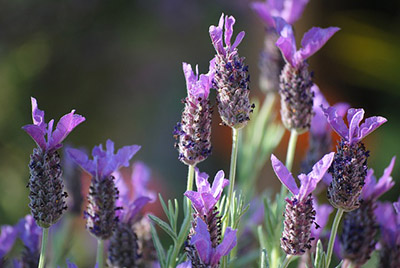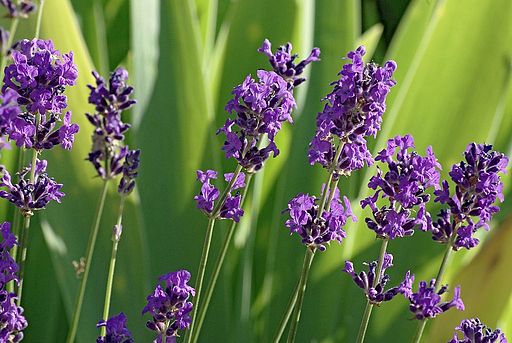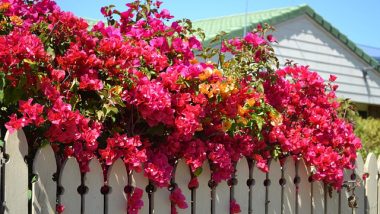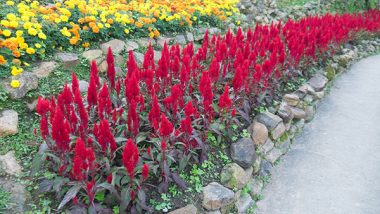Last updated on November 16th, 2025 at 09:33 am
Lavender Plants in The Garden. These plants can be used as hedges or stand-alone plants. There are many types of Lavender that can be used in the garden. Lavenders will give off a strong aromatic scent. Below are some of the most common Lavenders. In places where the temperatures reach over 110° Fahrenheit during the mid-summer months, it’s best to plant them in the morning sun and afternoon shade. It is important to note they need at least 6 hrs. hours of sunshine to grow and produce colorful blooms.
Spanish Lavender (Lavendula Stoechas)
Sometimes called the rabbit ears lavender. The flower does resemble bunny ears (see photo below). They bloom profusely during the spring seasons. It loves hot dry or humid climates perfect for the Southwest. Place it in the garden as it will attract butterflies and can be planted in a pot or in the ground. Make sure you have good loamy soil and drainage. Spanish Lavender will grow about 2 maybe 3 feet tall and wide.
It’s great for short border plants in a walk-way entrance.

Munstead Lavender (Lavandula angustifolia)
Munstead Lavender is an English lavender. The flower is smaller than the Spanish Lavender but very fragrant. Place it in a herb or rock garden as it does not mind the heat providing it has water and drainage. It loves full but can tolerate a few hours of shade.
English Lavender
(Lavandula Angustifolia) also called common lavender. Will do great in the southwest even in Desert gardens. It likes full sun but loves good loamy soil that will drain well. It is used in gardens throughout the Southwest for its strong fragrance and low water usage.


French Lavender
Wooly grey-colored foliage has a very aromatic scent. The blooms seem to last forever and do well in alkaline soil perfect for the Southwest region. Will grow about 2 ft. tall and 1-2 ft. wide.

How does Lavender Propagate
Lavender spreads through seeds, cuttings, or layering. Seeds take time and often yield mixed results, so many prefer cuttings. To propagate from cuttings, snip a 4-6 inch softwood stem in spring or summer. Make sure it’s healthy and free of flowers. Remove the lower leaves, dip the cut end in rooting hormone, and plant it in moist soil. Keep it warm with indirect light, and you’ll see roots in a few weeks. For layering, pin one of the plant’s lower branches to the soil and cover part of it. Roots will form where the stem touches the soil, and you can transplant it after a few months.

Problems with Lavender Plants
Lavender plants can face a variety of challenges, and one of the most significant problems they encounter is Fusarium wilt, which is a type of fungus. This fungus can invade the roots and stems of lavender, causing the plants to become weak and unhealthy. When lavender is infected with Fusarium wilt, you may notice that the leaves begin to wilt, the color may change, and overall growth can become stunted. It’s essential to address this issue quickly to save the plants.
To treat Fusarium wilt effectively, applying a good fungicide is crucial. This kind of treatment helps in targeting the fungus and reducing its presence on the plants. However, it’s important to understand that a single application is usually not enough to completely eliminate the fungus. You will likely need to spray the fungicide multiple times over a period of weeks to ensure that the fungus is thoroughly removed. Consistency in applying the treatment is key to restoring the health of your lavender plants and preventing further issues. With patience and proper care, it is possible to bring those lavender plants back to flourishing health.
Whiteflies will attack this plant they will kill the plant, but it will look bad if heavily infested. Use a good systemic insecticide to kill them. Go organic and use neem oil spray or insecticidal soap. The store-bought soaps will work if you follow instructions accordingly. Aphids will attack this plant causing the leaves to turn yellow. They basically suck the life out of the plant spray with an insecticide or go organic and use insecticidal soaps.
Read more about Insecticidal soaps here.
Problems with Lavender Plants
Powdery mildew is a common and frustrating issue for gardeners. It shows up as a white, powder-like coating on stems, flowers, and leaves. This fungus can weaken plants, affecting their growth and appearance. It thrives in warm, humid conditions, especially when airflow is poor. If left untreated, it can spread quickly, making it harder to control. Recognizing the symptoms early is key to keeping your plants healthy.
Spray with a good-quality fungicide to eliminate this fungus and stop it from spreading. Neem oil is an excellent organic option and is effective at treating powdery mildew, but it typically requires multiple applications to fully resolve the issue. Be sure to follow label directions and reapply consistently for best results. To prevent powdery mildew from returning, avoid using overhead sprinklers, as excess moisture on the foliage encourages fungal growth. Also, make sure your plants are not receiving more than 50% shade—Gazanias grown in too much shade tend to stay damp longer and are far more prone to fungal infections.
Does Lavender help you sleep?
Lavender plants do help you sleep and according to research – Oils with Lavender is the best way to use it. Not only Lavender but other plants if done correctly will help you sleep better. Read more here –The glory of gardening.
Lavender plants do well in USDA Zones 5 through 10.

Greenhouse Manager, Master Gardener, and Webmaster.
If you have any questions or enjoyed this post, feel free to share your thoughts in the comments below.




Hi:
When will plants such as lavender and herbs arrive at your nursery for purchase?
We are hoping they will arrive in mi-to-late February. Best to give us a call before you arrive. The store at 540 N. Telhore should have them. Call 575 202 1749. Normally Lavender plants arrive at our Nurseries in Mid-April.
Visit Calathea Plants.